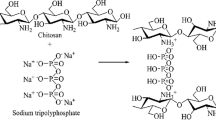Summary
Chitosan (CS) metal complexes with bivalent metal ions, including Cu(II), Zn(II), Fe(II) were prepared, and characterized by FT-IR, XRD, AAS and elemental analysis. The crystalline and structural properties of chitosan-metal complexes were different from those of chitosan, and the -NH2, -OH groups in chitosan molecule were considered as the dominating reactive sites. In vitro antimicrobial activities of the obtained chitosan-metal complexes, which were found to be much better than free chitosan and metal salts, were examined against two gram-positive bacteria (S. aureus and S. epidermidis), two gram-negative bacteria (E. coli and P. aeruginosa) and two fungi (C. albicans and C. parapsilosis). Results indicatd that the inhibitory effects of chitosan-metal complexes were dependent on the property of metal ions, the molecular weight and degree of deacetylation of chitosan and environmental pH values. Electro microscopy confirmed that the exposure of S. auresus to the chitosan-Cu(II) complex resulted in the disruption of cell envelop. Based on the discussion upon the antimicrobial mechanism of chitosan-metal complexes and their molecular structures, the structure-activity correlation for the antimicrobial activities was elucidated. All the results show that chitosan-metal complexes are a promising candidate for novel antimicrobial agents that can be used in cosmetic, food, textile et al.
Similar content being viewed by others
References
Roberts GAF (1992) Chitin chemistry. Macmillian Press, London
Brine CJ, Sandford PA, Zikakis JP (1992) Advanced chitin and chitosan. Elsevier, New York
Huang R, Du Y, Yang J (2003) Carbohydr Polym 51:431
Qin C, Du Y, Xiao L, Li Z, Gao X (2002) Int J Biol Macromol 31:111
Qin C, Zhou B, Zeng L, Zhang Z, Liu Y, Du Y, Xiao L (2004) Food Chem 84:107
Kobayashi M, Natanabe T, Suzuki S, Suzuki M (1990) Microbiol Immuno 34:413
Liu H, Du Y, Wang X, Sun L (2004) Int J Food Microbiol 95:417
Liu H, Du Y, Wang X, Hu Y, Kennedy JF (2004) Carbohydr Polym 56:243
Jeon YJ, Kim SK (2000) Carbohydr Polym 41:133
Roller S, Covill N (1999) Inter J Food Microbiol 47:67
Entsar IR, Moham ETB, Christian VS, Gay S, Walter S (2003) Biomacromolecules 4:1457
Chun HK, Jang WC, Heung JC, Kyu SC (1994) Polym Bull 38:387
Chen L, Du Y, Liu Y (2000) J Wuhan Univ 46:191
Huang R, Du Y, Zhang L, Liu H, Fan L (2004) React Funct Polym 59:41
Qin C, Du Y, Xiao L, Liu Y, Yu H, (2002) J Appl Polym Sci 86:1724
Wang X, Du Y, Liu H (2004) Carbohydr Polym 56:21
Liu H, Du Y, Wang X (2004) Carbohydr Polym 55:291
Odunola OA (1993) Synth React Inorg Met-Org Chem 23:1241
Zheng H, Du Y, Yu J, Xiao L (2000) J Wuhan Univ 46:685
Qin C, Du Y, Xiao L (2002) Polym Degrad Stabil 76:211
Speciale A, Musumeci R, Blandino MG, Caccamo IF, Nicoletti G (2002) Int J Antimicrob Ag 19:111
Muzzarelli RAA, Ferrero A, Pizzoli M (1972) Talanta 19:1222
Wang AQ, Li HQ, Yu XD (1999) Chinese Appl Chem 19:77
Tang LG, Hon DNS (2001) J Appl Polym Sci 79:1476
Yang J, Du Y, Qin C (2003) Chinese J Anal Sci 19:282
Jin DM, Zhu WX (1996) Bio-inorganic chemistry, Chinese Science Publisher, Beijing
Muzarelli RAA (1996) Carbohy Polym 29:309
Fred B, Ralph GP (1967) Mechanisms of inorganic reactions, John Wiley and Sons, Inc.
No HK, Park NY, Lee SH, Meyers SP (2002) Inter J Food Microb 74:65
Liu XF, Guan YL, Yang DZ, Li Z, Yao KD (2000) J Appl Polym Sci 79:1324
Author information
Authors and Affiliations
Corresponding author
Rights and permissions
About this article
Cite this article
Wang, X., Du, Y., Fan, L. et al. Chitosan- metal complexes as antimicrobial agent: Synthesis, characterization and Structure-activity study. Polym. Bull. 55, 105–113 (2005). https://doi.org/10.1007/s00289-005-0414-1
Received:
Revised:
Accepted:
Published:
Issue Date:
DOI: https://doi.org/10.1007/s00289-005-0414-1




